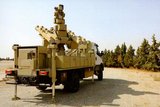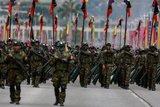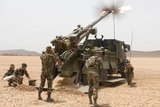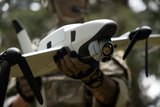Long-range radar handed over to US Missile Defence Agency
LRDR can provide the ability to simultaneously search and track multiple small objects. (Photo: Lockheed Martin)
The US MDA has taken delivery of Lockheed Martin’s LRDR at Clear Space Force Station in Alaska. The radar was delivered after completion of DD250 final acceptance in preparation for an Operational Capability Baseline (OCB) decision and final transition to users.
The system has started Space Domain Awareness data collection for the US Space Force as part of process to transition to operators.
LRDR provides the ability to simultaneously search and track multiple small objects including all classes of ballistic missiles, at very long ranges, under continuous operation.
Its discrimination capability will allow LRDR to identify lethal objects such as enemy warheads and differentiate them from non-lethal decoys.
LRDR, along with other elements of the Missile Defense System, will preserve homeland defence interceptor inventory by conserving the number of ground-based interceptors required for threat engagement.
LRDR operates in S-band frequencies and features a scalable, open-systems architecture designed to be extended to counter evolving threats without changing the hardware design.
It was integrated into the Missile Defense System through the command and control, battle management and communications element. As an example of LRDR’s open systems architecture, Lockheed Martin will add new capability in support of hypersonic defence, which will give users actionable information to support faster decision-making.
More from Air Warfare
-
![Bell advances to next stage of US Army’s aviator training programme competition]()
Bell advances to next stage of US Army’s aviator training programme competition
The US Army plans to award a contract through its Flight School Next competition to replace its UH-72A Lakota by late 2026.
-
![Denmark to bolster maritime defences as P-8A FMS deal approved by US]()
Denmark to bolster maritime defences as P-8A FMS deal approved by US
The NATO country continues to focus on building up its maritime surveillance and enforcement capabilities as part of a major investment in its Arctic defences.
-
![Spain moves ahead with transport, intelligence and training aircraft modernisation efforts]()
Spain moves ahead with transport, intelligence and training aircraft modernisation efforts
Confirming its C295 order in late December, the Spanish Ministry of Defence also awarded Airbus with its Hurjet procurement contract and both Airbus and Indra with a contract to investigate a proposed Signals Intelligence aircraft solution by 2028.
-
![December Drone Digest: Germany, Australia and US champion indigenous UAV production]()
December Drone Digest: Germany, Australia and US champion indigenous UAV production
One of the key trends seen in December has been the rise in indigenous investment within the UAV market, particularly across certain countries, with Germany, Australia and the US focusing on their commitments to sovereign development.
-
![What might next-generation military aircrew training look like?]()
What might next-generation military aircrew training look like?
Changing roles for combat aircraft fleets, the rise of simulation and LVC technologies, and the increasing cost of flight hours could all be leading to a paradigm shift in military pilot training.
-
![2025 air market review: European defence independence, next-gen tech and export concerns dominate]()
2025 air market review: European defence independence, next-gen tech and export concerns dominate
This year’s (geo)political turmoil has challenged many long-prevailing assumptions, leading to far-reaching consequences for air forces and their supplier bases in industry worldwide – with five key trends in review for 2025.

























